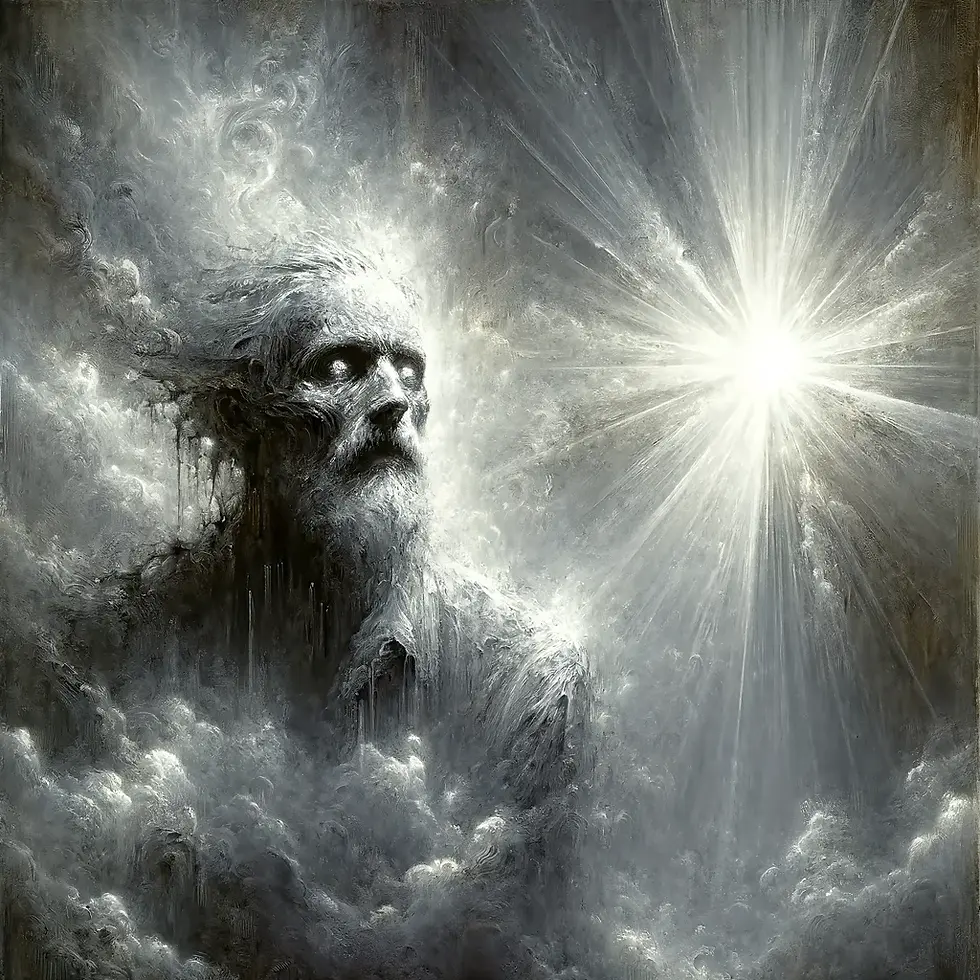The Aged Soul Before Glory: Simul Iustus et Peccator
- Peacekeeper

- Aug 3, 2025
- 2 min read

This image serves as a visual emblem of the Christian’s inner reality: an aged, weathered figure standing amidst shadow and light, caught between decay and divine illumination. It symbolizes the lifelong tension of the believer: fully justified by grace, yet still bearing the marks of sin. The radiance from above confronts the darkness within, making this not just art, but confession of our condition as simul iustus et peccator.
1. The Aged Figure in Darkness (Left):
This figure represents fallen humanity, marked by age, decay, and a haunted look as though bearing the weight of sin, mortality, and divine absence. The deterioration of the form into cloud and shadow suggests the creature’s fragility, the dust-to-dust reality of human life (cf. Genesis 3:19), or the inward corruption of the sinful nature (cor incurvatum in se—“the heart curved inward upon itself,” as Luther put it).
2. The Light (Right):
The radiant burst of light on the right symbolizes the divine Logos: the uncreated Light of Go breaking through darkness. In Johannine terms, “The light shines in the darkness, and the darkness has not overcome it” (John 1:5). It may also signify the Revelation of God, particularly through Christ, or the illumination of the Spirit which breaks the sinner’s delusion and reorients them toward truth.
3. The Gaze Toward the Light:
The figure’s intense gaze toward the light is central. Theologically, this represents repentance, conversion, or the soul awakening to the reality of God's holiness and mercy. There's a tension between judgment and hope here with the eyes are filled with awe, maybe fear, maybe longing, suggesting an encounter with transcendence.
4. The Environment (Clouds and Shadows):
The surrounding storm-like clouds indicate the mystery and majesty of God, or the hiddenness of divine glory (cf. Isaiah 45:15 – “Truly, you are a God who hides himself”). They also depict the veil between heaven and earth, which is pierced only by grace.
This is seen as an image of the simul iustus et peccator (simultaneously justified and sinner). The figure is clearly marked by the corruption of sin, yet turns toward divine light. The holiness is not in himself, but in the one he looks toward.
It also evokes themes of justification by faith, not by self-purification, one turns toward the light not because one is pure, but because one is called.
Four-Tier Motto:
Fallen in Flesh
Pierced by Light
Turned Toward Glory
Held by Grace
Explanation of Each Tier:
Fallen in Flesh – Humanity's original condition. A recognition of sin, mortality, and the corruption that marks every human born of Adam (Romans 5:12). The aged figure embodies this.
Pierced by Light – Divine intervention. A moment of revelation, conviction, or illumination, the inbreaking of God’s Word or Spirit into the darkness (John 1:9, Hebrews 4:12).
Turned Toward Glory – The response of the regenerated will: repentance, faith, and longing. The figure’s gaze upward, haunted but drawn, reflects the journey toward sanctification (Philippians 3:14).
Held by Grace – The conclusion and the promise. Perseverance doesn’t rest on human strength, but the grip of God’s grace alone (Ephesians 2:8–9, Romans 8:30).



Comments